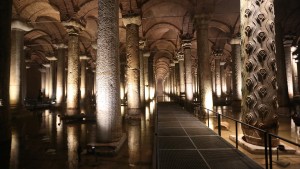Basilica Cistern invites art lovers to a magical world!
Basilica Cistern invites art lovers to a magical world!
Located in the historical peninsula of Istanbul; Basilica Cistern, which is considered as one of the most important cultural heritages of the world and one of the early architectural examples that have survived to the present day, has been attracting great attention from local and foreign tourists since its renewed face on July 23. Basilica Cistern, operated by İBB Kültür AŞ, welcomes its visitors every day of the week between 09.00 and 19.00.
The historical cistern, which was restored by İBB Heritage in line with the understanding of contemporary museology, takes its visitors on a journey into history with the events it hosts in its fascinating atmosphere.
About the Basilica Cistern
Basilica Cistern, one of the cultural assets that we can trace the glorious history of Istanbul, was built by Justinian I in the 6th century. The historical cistern, which was like a stagnant sea in its time with a water capacity of 80 thousand tons, is called "Cisterna Basilica" in Latin.
The building, which is also known as the Basilica Cistern today, distributed the water obtained from the waterways and rain to the Great Palace where the emperors resided and to the surrounding structures, meeting the water needs of the city for centuries. Basilica planned Basilica Cistern, which is the largest closed cistern in the city and attracts attention with its more reused carrier elements than other closed cisterns; It contains a total of 336 columns in a row of 28 east-west oriented and 12 south-north oriented columns.
The cistern, which covers an area of approximately 1000 m², is 140 meters long and 65 meters wide; After the conquest of Istanbul by the Ottomans in 1453, it was used for a while for the needs of Topkapı Palace. It is also known that the historical cistern was used as a water well by the people with the slow residential development in the region. The structure, which was not noticed by Westerners until the middle of the 16th century, was almost rediscovered by Petrus Gyllius, a naturalist and topographer who lived in Istanbul between 1544 and 1555.
In the Ottoman Empire, III. Ahmet, for the first time by the architect Mehmet Ağa from Kayseri, II. The Basilica Cistern, which was repaired for the second time during the reign of Abdulhamid, continued to undergo repairs in the following years. In 1955-1960, the 9 columns of the cistern, which were at risk of breaking, were covered with a thick layer of concrete. Medusa heads, the most important symbol of the Basilica, were discovered during the extensive repair and cleaning works carried out by the Istanbul Metropolitan Municipality between 1985 and 1987. Of the Medusa heads used as column bases, the one located on the west of the building stands upside down, while the one on the east stands horizontally. The Medusa heads here are thought to have been brought from Çemberlitaş, as they show similar characteristics to the Medusa head samples found in the garden of the Istanbul Archaeological Museums and near the Tiled Kiosk.
The magnificent building, which was opened as a museum by the IMM in 1987 after the restoration, also hosted various national and international events over time. The multi-layered memory of the Basilica Cistern, which still preserves the value it has gained as the common heritage of humanity, continues to be a source of inspiration for the future as well. You can also experience the chance to see this mysterious place on our tours. Istanbul Package Tours

